Brazil has a recent painful experience of national tragedy. On 25 January 2019, the city of Brumadinho suffered a disaster — a dam collapse that claimed dozens of lives and caused extensive environmental damage. While the contexts of this tragedy and the Kakhovka HPP dam breach differ significantly, both events share water as a force of destruction.
By comparing such experiences — managing the aftermath, commemorating the victims, assessing damage, compensating those affected, and holding those responsible to account — we do more than just share information; we build connections that can translate into tangible support.
For Ukraine, the experience of memorialisation is particularly important. The Brumadinho Memorial stands out not only for its conceptual depth and visual language of memory but also because the victims’ families became active participants in its creation and management. This approach, where memory is shaped collaboratively rather than imposed, can serve as a model for Ukrainian initiatives aiming to preserve the truth about the war for independence, honour the victims of Russian aggression, and at the same time build international solidarity and support for Ukraine.
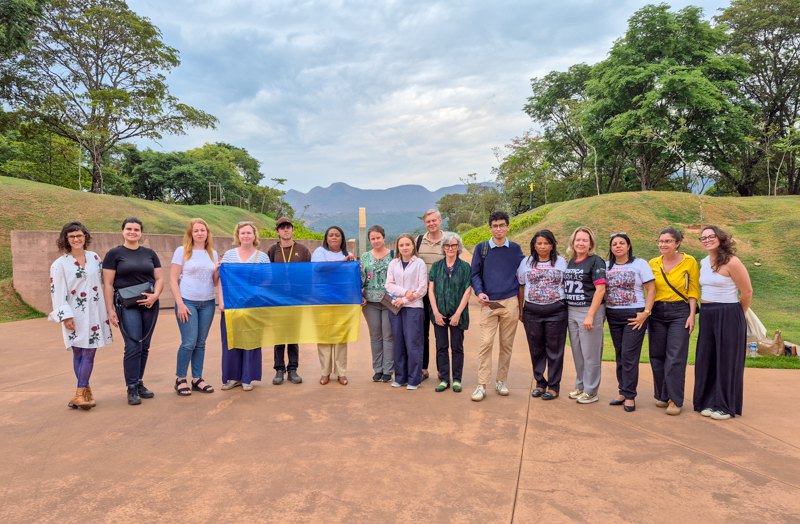
***
The Brumadinho Memorial, designed by architect Gustavo Penna, pays tribute to the 272 people who lost their lives in the tragic dam collapse on 25 January 2019. This commemorative space was created while the search for bodies was still ongoing, a process that continues to this day.
The Brumadinho Memorial is both a place of remembrance and a gathering space for families to grieve together. It reflects the consequences of the disaster, tells its story, and prompts reflection on how it might have been avoided. “The Brumadinho Memorial is a place where architecture meets memory. It embraces pain and transforms it into resistance against forgetting, giving new meaning to the site of the tragedy,” emphasizes architect Gustavo Penna.

From the very beginning, the creation of the memorial was conceived as a close collaboration with the families of the disaster’s victims. The local firm Gustavo Penna Arquitetos & Associados, or GPAA, was chosen to develop the project.
At the entrance, the monumental space of the memorial immediately signals its purpose. The twisted, fragmented pavilion is made of exposed concrete and coated with a red pigment derived from toxic iron ore waste — the same waste that buried 251 Vale mining company employees in the company cafeteria and another 21 local residents. The thick, undulating concrete form symbolises shattered dreams and the unstoppable force of the mud that destroyed everything in its path.

“I never imagined that in my life I would be creating a memorial,” reflects Penna. “After experiencing this, I feel that architecture has changed for me. I was able to stand with the victims, to create an instrument of protest, of outrage. A fortress where the feeling of resistance to erasing the memory of this tragedy can live — a place that stands against forgetting.”
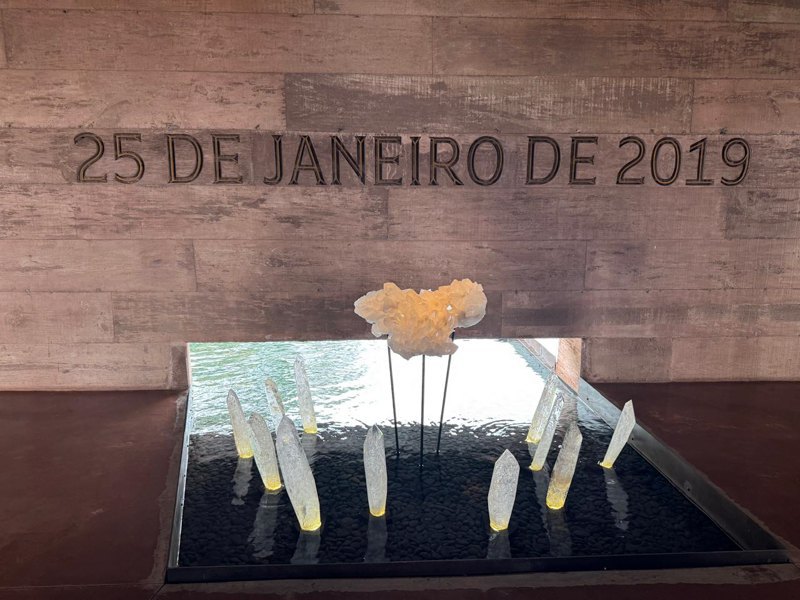
The pavilion’s flowing form is inspired by a small skylight. It is positioned so that every year on 25 January at 12:28 — the moment of the disaster — a beam of light passes through the ceiling and hits heart-shaped crystals, filling the space with light that the victims could not see on that tragic day.
A small chapel-like space opens outward onto the memorial grounds. The path indicated by the pavilion is an uneven 230-metre-long fissure — a literal and symbolic rupture that cuts through the landscape and marks the exact site of the dam’s collapse.
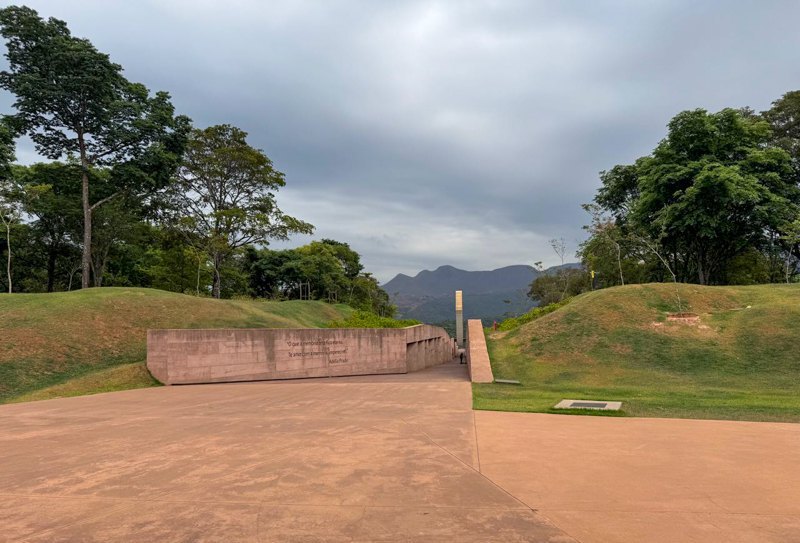
As visitors descend through this trench-like corridor, they encounter the names of every victim, including unborn children, engraved on the walls. If a victim’s family did not consent to display the name of their loved one, it is omitted, replaced instead by a symbolic ipê tree flower, representing resilience.
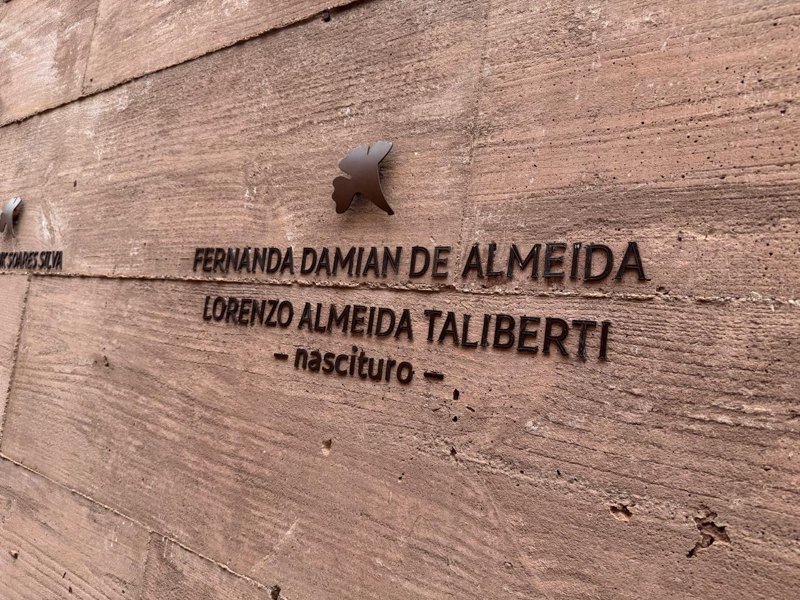

Before reaching the midpoint of the path, three spaces open up within the memorial — one to the left and two to the right. To the left is the space of memory. To the right are the testimony space and a sacred area where the recovered remains of the victims are kept.
In the memory space, families honour their loved ones: their portraits and cherished belongings are displayed, and the emotions of empathy are heightened by moving music composed by Brazilian musician Berni Seppas. In the testimony space, the tragic story is replayed repeatedly through video footage from the company’s surveillance cameras, capturing almost every angle of the horrific events of that day.
Along the path of memory, two streams flow, eventually merging before falling into the memorial lake. A square structure, tilted at an angle, symbolises the destructive imbalance caused by human interference with the surrounding landscape — the catastrophic consequences of encroaching on nature and disregarding respect for it. The cost of these actions is life.
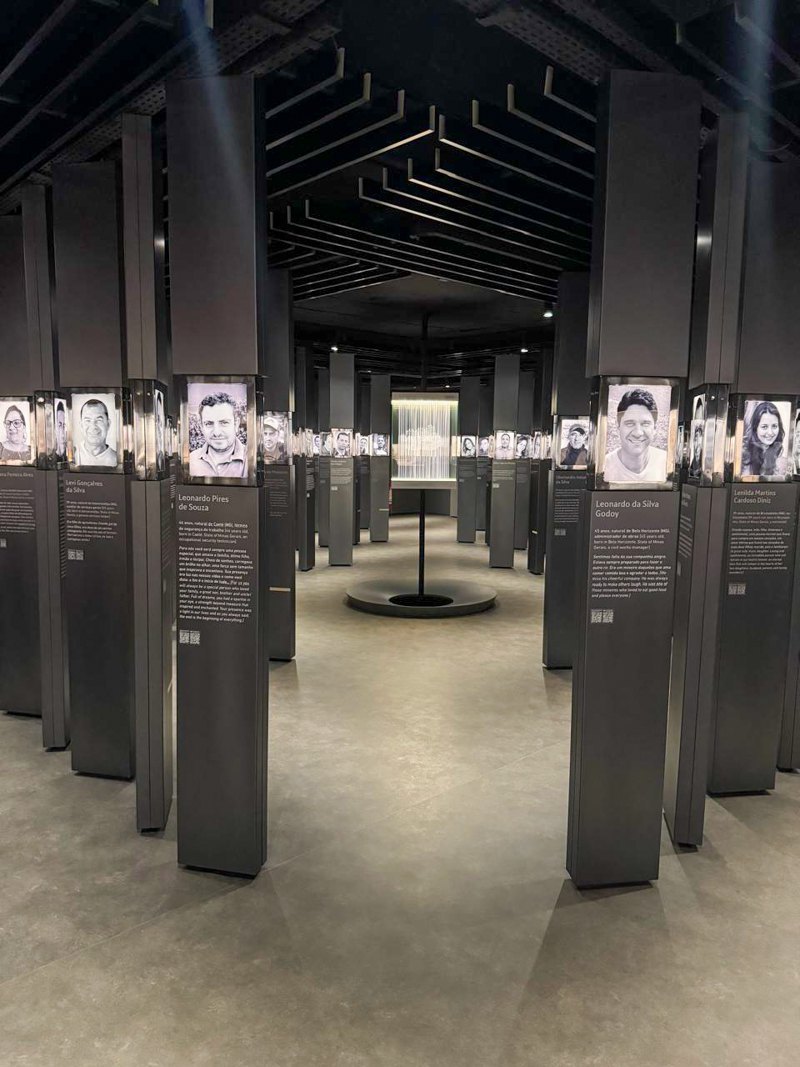

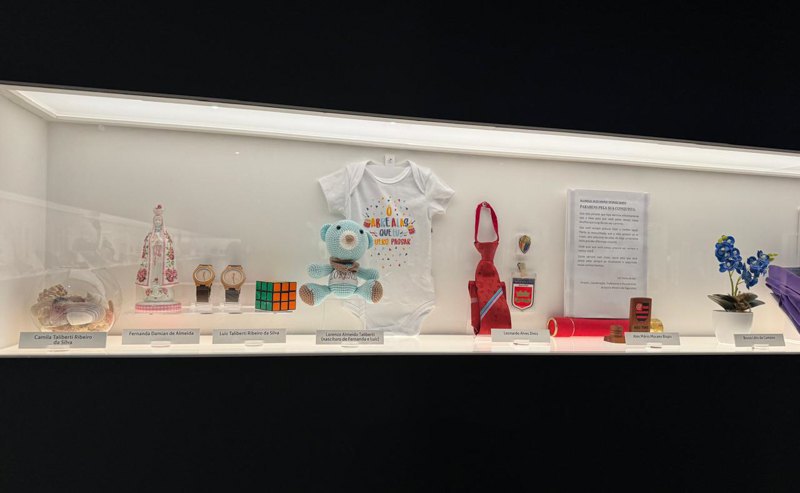
“The square is a unique creation of humans,” emphasizes Gustavo Penna. “Squares don’t exist in nature. If you see a square somewhere, it means a person was there. Why does this square head weep? Because it represents an end point, a human error — the mistake of thinking we can control everything. On that day, humans controlled nothing. This tragedy was caused by negligence, greed, and human folly.”

On the memorial grounds, 272 yellow ipê trees have been planted in memory of each victim. These trees change with the seasons. The ipê flower’s shape is incorporated throughout the memorial as a symbol of each victim and the legacy they left behind.

The journey through the Brumadinho Memorial concludes at a viewing platform, offering a space for reflection with a view over the valley transformed by the disaster. Below, trucks move around those still working on the excavation to recover the remains of the last two victims.
The Brumadinho Memorial preserves the memory of the tragic events of 25 January 2019, while also speaking to the responsibility that comes with disregarding respect for the environment.
***
The Brumadinho Memorial was made possible through the coordinated efforts of the victims’ families. They came together in the days following the dam collapse in January 2019, united by grief, outrage, and the need for answers. A collective sense of injustice and abandonment prompted them to create AVABRUM — the Association of Families of Victims and Affected People of the Corrego do Feijão Dam Collapse. Since then, AVABRUM has been the primary voice of the families; the association works to preserve the memory of the victims, ensure accountability, and secure guarantees that such tragedies do not happen again. This spontaneous organisation is an example of civic resistance to both mining corporations’ authority and state negligence in the context of mining activities.
From its inception, AVABRUM advocated for a space dedicated to memory, reflection, and education on the disaster. This led to the creation of the Brumadinho Memorial — a response to the families’ desire to transform their grief into a living memory and collective learning.
The site chosen for its construction is near the collapse zone, maintaining a direct connection with the devastated area. The architectural project was developed through a public competition. Its aesthetic and exhibition elements were created with the active participation of the families, who contributed documents, testimonies, photographs, and research on the tragedy. The memorial is not only a place of mourning for those who lost loved ones but also an institution that sparks discussion on social responsibility, memory, the environment, labour, human rights, architecture, and other important issues.
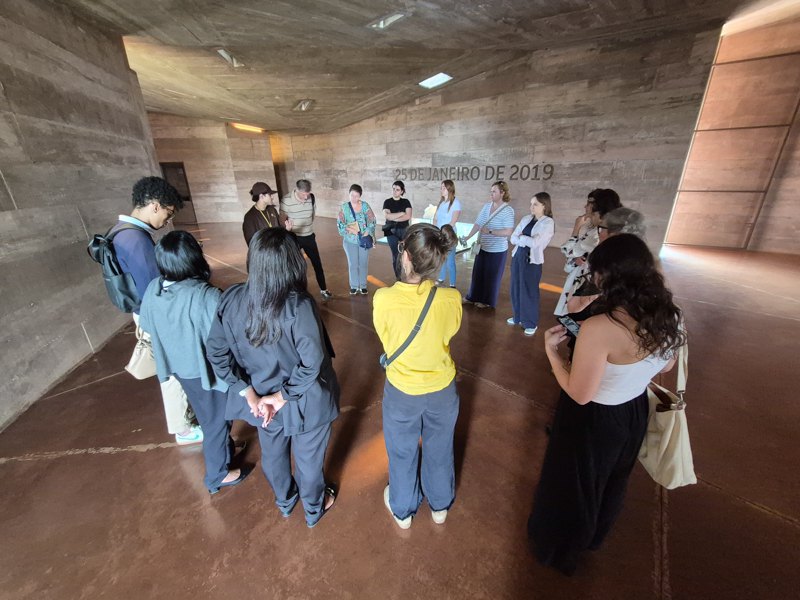
***
A central concern for AVABRUM has always been the pursuit of justice. The fight for justice takes place on multiple fronts. AVABRUM operates with the support of independent legal assistance through the Cordillera Institute, closely monitors criminal and civil proceedings, and maintains ongoing dialogue with the prosecution and the public defender’s office. Additionally, the association conducts communication and social mobilisation campaigns, participates in hearings, and applies pressure on authorities in Brazil and abroad to hold perpetrators accountable and restore justice.
These persistent efforts have been essential to breaking the silence that often surrounds major environmental disasters and to challenging the predatory model of the mining industry, which jeopardises human lives in the pursuit of profit. The justice sought by the families is also a symbolic struggle for truth, the dignity of the victims, and systemic change — confronting structures that normalise environmental and social destruction. Seeking and preserving truth is one of AVABRUM’s core objectives.
***
Another goal of the association is to secure compensation for damages — a path that is far from easy. Beyond legal delays and the technical complexity of cases, families face the economic and political influence of mining companies like Vale, which seek to minimise their responsibility and reduce reparations to mere financial compensation.
Moreover, the families constantly endure emotional strain, public attention, and the risk that their suffering may be exploited for opportunistic purposes. Despite these challenges, AVABRUM continues to act, demanding material, symbolic, and environmental reparations, as well as the effective involvement of victims’ families at every stage of the legal process.
***
The Brumadinho Memorial also carries out ongoing educational activities — guided tours, seminars, and lectures — to preserve the memory of the Corrego do Feijão mine collapse and serve as a constant tool to raise awareness about the memorial’s core themes: environmental preservation, memory, and human rights protection. The memorial houses a reference centre: a digital space that collects and provides access to cultural, academic, and official materials related to the disaster. It contains written and audio documents, museum artefacts (personal belongings of the victims, items from the Minas Gerais fire service), photographs, videos, interviews, and other historical records about the tragedy.
The educational mission is to transform knowledge of the collapse and its consequences into a tool for environmental preservation and social consciousness, combining memory with civic engagement.
***
AVABRUM maintains continuous dialogue with communities affected by dams in other regions of Brazil, as well as with families of victims of other tragedies: the Kiss nightclub fire (Rio Grande do Sul, 2013), the Mariana dam collapse (Minas Gerais, 2015), the Ninho do Urubu fire (Rio de Janeiro, 2019), and land subsidence in Maceió (Alagoas, 2019).
The association also collaborates with international organisations working in environmental justice and human rights protection through meetings, joint projects, and experience-sharing. AVABRUM believes that uniting voices and strengthening global networks is essential to counter the economic model that perpetuates tragedies across countries, leaving behind destruction and impunity. Solidarity among victims has therefore become a form of global resistance.
***
The state plays an official role in maintaining the memorial and managing reparations, but this support is not always sufficient. Families and AVABRUM remain vigilant to ensure that governmental obligations are fulfilled. In many cases, pressure from civil society has been decisive in prompting state action. Thus, the Brumadinho Memorial is not only the result of public policy but also the perseverance of families transforming trauma into a collective project of memory and justice.
This material is the result of a joint initiative by Justiça Global and the International Renaissance Foundation, discussing the challenges of socio-environmental protection and the pursuit of justice.







